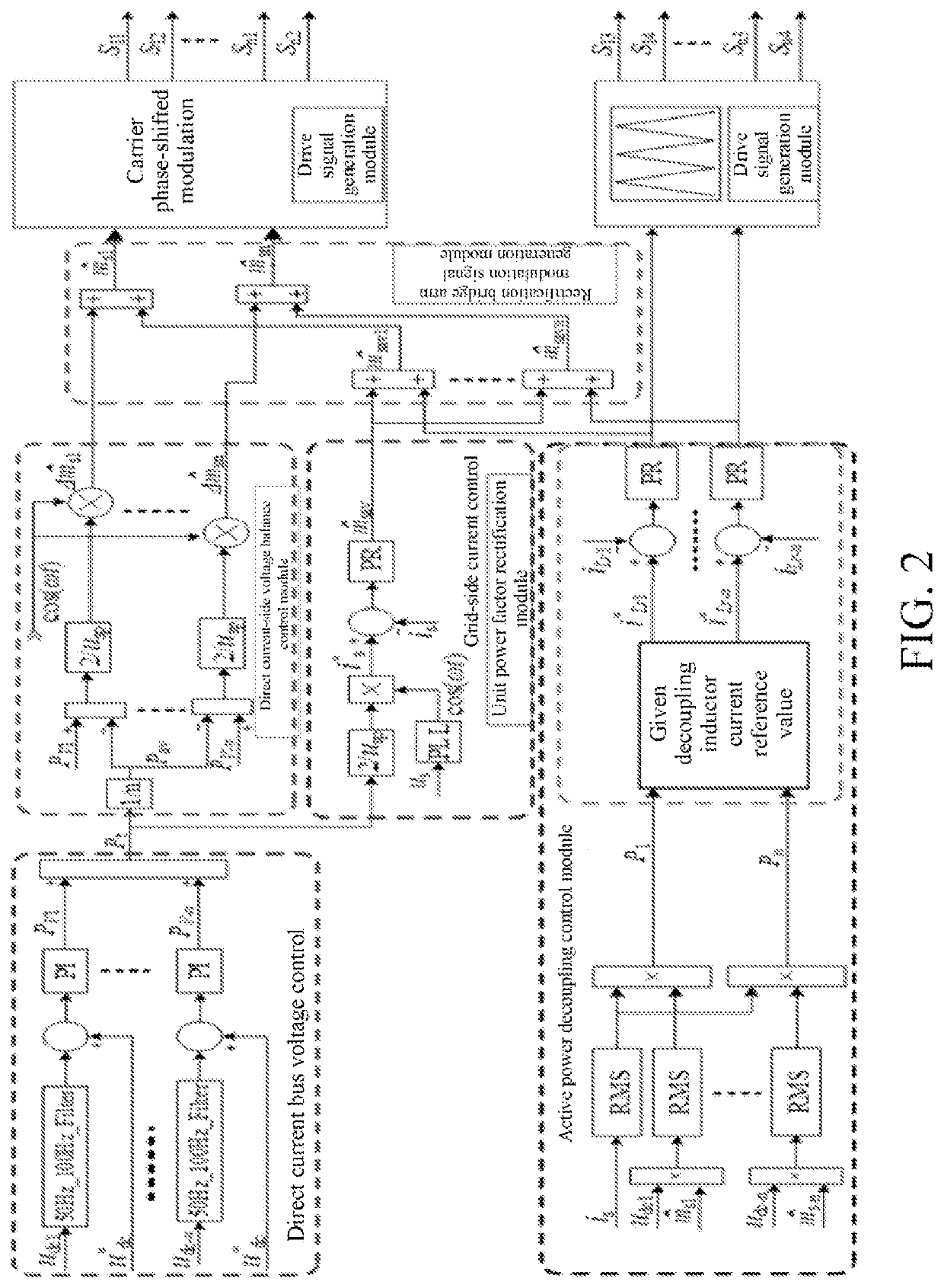Single-phase device-multiplexing active power decoupling cascaded rectifier and control method thereof
a cascade rectifier and single-phase device technology, applied in the direction of ac-dc conversion without reversal, power conversion systems, electrical apparatus, etc., can solve the problems of poor controllability, ac-ac topology, low efficiency, etc., and achieve the effect of verifying the effectiveness of the proposed control policy
- Summary
- Abstract
- Description
- Claims
- Application Information
AI Technical Summary
Benefits of technology
Problems solved by technology
Method used
Image
Examples
embodiment 1
[0063]In one or more implementations, a multi-module device-multiplexing active power decoupling single-phase H-bridge cascaded rectifier is disclosed, and a topology thereof is shown in FIG. 1, including: n device-multiplexing active power decoupling H-bridge units (Bridge 1, Bridge 2, . . . , and Bridge n) that are cascaded, DC-side capacitors Cu1, Cl1, . . . , Cu-n, and Cl-n of the units being decoupling capacitors of Bridge 1, . . . , and Bridge n, and ucu1, ucl1, . . . , ucu-n, and ucl-n being decoupling capacitor voltages; Lr1, . . . , and Lrn being decoupling inductors, iLr1, . . . , and iLr-n being currents flowing through the decoupling inductors Lr1, . . . , and Lrn; and R1, . . . , and Rn being DC-side resistive loads, and udc1, . . . , and udc-n being DC-side output voltages.
[0064]A topology structure of the device-multiplexing active power decoupling H-bridge unit specifically includes: a bridge arm H1 and a bridge arm H2 connected in parallel, a decoupling capacitor br...
embodiment 2
[0094]In this embodiment, n=2, that is, a single-phase device-multiplexing active power decoupling rectifier includes two device-multiplexing active power decoupling H-bridge units that are cascaded. A control policy thereof is studied, a simulation model is built in Matlab / Simulink, and correctness and effectiveness of the proposed control policy is verified.
[0095]FIG. 6 shows a single-phase CHBR device-multiplexing active power topology with two modules cascaded. The entire system includes two single-phase H-bridge rectifier device-multiplexing active power decoupling units that are cascaded. DC-side capacitors Cu1, Cl1, Cu2, and Cl2 of the units are decoupling capacitors of Bridge 1 and Bridge 2 respectively, ucu1, ucl2, ucu2, and ucl2 are decoupling capacitor voltages; Lr1 and Lr2 are decoupling inductors, and iLr1 and iLr2 are currents flowing through the decoupling inductors Lr1 and Lr2; R1 and R2 are DC-side resistive loads, and udc1 and udc2 are DC-side output voltages.
[0096...
embodiment 3
[0107]In one or more implementations, a terminal device is provided, including a server. The server includes a memory, a processor, and a computer program stored in the memory and capable of being run on the processor, and the processor, when executing the program, implements the control policy in Embodiment 1. For brevity, details are not described herein again.
[0108]It should be understood that in this embodiment, the processor may be a central processing unit (CPU); or the processor may be another general purpose processor, a digital signal processor (DSP), an application-specific integrated circuit (ASIC), a field programmable gate array (FPGA) or another programmable logical device, a discrete gate or a transistor logical device, a discrete hardware component, or the like. The general-purpose processor may be a microprocessor, or the processor may also be any conventional processor or the like.
[0109]The memory may include a read-only memory and a random-access memory, and provi...
PUM
 Login to View More
Login to View More Abstract
Description
Claims
Application Information
 Login to View More
Login to View More - R&D
- Intellectual Property
- Life Sciences
- Materials
- Tech Scout
- Unparalleled Data Quality
- Higher Quality Content
- 60% Fewer Hallucinations
Browse by: Latest US Patents, China's latest patents, Technical Efficacy Thesaurus, Application Domain, Technology Topic, Popular Technical Reports.
© 2025 PatSnap. All rights reserved.Legal|Privacy policy|Modern Slavery Act Transparency Statement|Sitemap|About US| Contact US: help@patsnap.com



